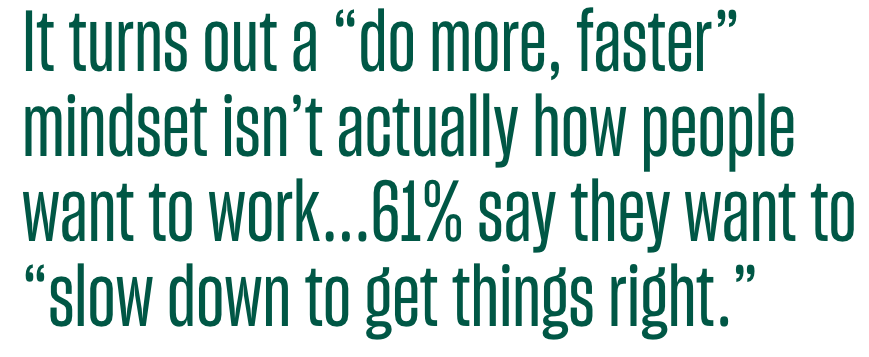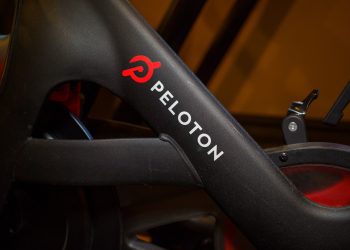Un informe reciente muestra que las empresas modernas pueden estar haciendo mal el trabajo y la productividad.
Por Ben Taylor | Artículo de trabajo en curso
Un informe reciente de “Work In Progress” muestra que las empresas modernas están obteniendo trabajo y productividad totalmente mal.
¿Cuándo nos obsesionamos tanto con la productividad? Vemos una avalancha diaria de anuncios sobre cómo hacer más trabajo. Las empresas de software dicen que sus herramientas ayudarán a los clientes a trabajar más rápido. Asistimos a talleres y seminarios para aumentar nuestra eficiencia.
Pero, ¿es realmente bueno para los negocios? ¿Y es realmente así como la gente quiere trabajar?
[ihc-hide-content ihc_mb_type = “mostrar” ihc_mb_who = “3,4,5,6” ihc_mb_template = “3”]
A pesar de nuestra obsesión por movernos más rápido y hacer más, las tasas de crecimiento de la productividad se han estancado significativamente en la última década. Según la Oficina de Estadísticas Laborales, solo estamos obteniendo un 1,4% más de productividad por año, la tasa de crecimiento más baja en 30 años y la segunda más baja desde mediados del siglo pasado.
Estamos produciendo más herramientas de productividad que nunca, pero cada vez tenemos menos que mostrar.


Quizás incluso más problemático, resulta que una mentalidad de “hacer más, más rápido” no es realmente la forma en que la gente quiere trabajar en primer lugar.
En una encuesta de trabajadores del conocimiento estadounidenses realizada por Dropbox, el 61% dice que quiere “reducir la velocidad para hacer las cosas bien”, mientras que solo el 41% * dice que quiere “ir rápido para lograr más”.
*We asked respondents how much they agreed with each statement separately, which is why the figures don’t add up to exactly 100%.
So why are so many companies so focused on increasing productivity at all costs?
One problem is precedent. Traditional industries like manufacturing have concrete ways to measure efficiency. If you can produce more goods over time with fewer resources, you’ve increased your productivity. It’s a mindset that dates back to at least the Industrial Revolution, and it’s a tempting blueprint for any modern-day business.
But the productivity calculus is much murkier when it comes to knowledge work—work that mostly involves dealing with information. Indeed, the Bureau of Labor Statistics cautions that productivity stats “for nonmanufacturing industries are often difficult to measure” and that “customers should be cautious when interpreting the data.” Do more lines of code per hour lead to better products? Would doubling the number of brainstorms per week make designers more creative?
Even in the face of inconclusive data, the desire to do more with less persists—particularly among upper management. At many companies, an IT decision maker or manager picks the team’s tools and sets the working cadence. But for the rank-and-file workers, these tools and timelines can create as many problems as opportunities.
“We’re hiring people for their minds, and then we’re not giving them any space to think.” – Dropbox CEO Drew Houston
In its 2018 Human Capital Trends report, Deloitte found that 47% of business and HR leaders were concerned that modern collaboration tools weren’t actually helping businesses achieve their goals. Between chat windows, project management tools, meeting alerts, and emails, workers find themselves in a constant state of reactive busyness—rather than proactively focusing on meaningful work.
Dropbox CEO Drew Houston talked about this phenomenon last fall at Dreamforce. “Our industry has been really good at finding ways to make the treadmill go faster,” he said. “We’re hiring people for their minds, and then we’re not giving them any space to think.”
Over the past couple years, we’ve taken a hard look at what we’re building at Dropbox. Are we simply building to create a sense of efficiency, or are we designing products that help people get the work right? What if we could give people more space to do the best work of their lives, rather than just doing the same work faster?
We’ve been inspired by a few Dropbox customers who are rejecting old models of productivity in favor of new working modes—methods better attuned to the realities of modern work. We’ve seen some organizations take a bottom-up mindset, looking to employees first for the best tools to use. We’ve noted companies that encourage different styles of working for employees in different countries and cultures, rather than a one-size-fits-all policy.
Adoptamos una mentalidad similar en Dropbox. Hemos creado productos como Dropbox Paper, un espacio de trabajo que permite a los equipos crear y coordinarse con menos distracciones, para reinventar cómo se realiza el trabajo, con énfasis no en trabajar más rápido, sino en mantener a los equipos en movimiento. Le hemos dado a nuestros propios empleados más espacio para concentrarse, con Hack Weeks para que las personas se alejen del correo electrónico y las reuniones y se centren en los proyectos que más les apasionan. (A saber, Smart Sync surgió de una Hack Week de toda la empresa).
Pero para diseñar realmente una mejor forma de trabajar, debemos observar más de cerca cómo está cambiando el lugar de trabajo. Tenemos que entender cómo trabaja la gente, cuándo trabaja y por qué.
En lugar de hiperproductividad, ¿qué condiciones llevan realmente a que las personas hagan su mejor trabajo?
[/ ihc-hide-content]












